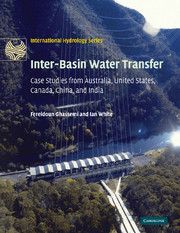Book contents
- Frontmatter
- Contents
- Foreword
- Overview and Scope
- Acknowledgements
- List of Abbreviations
- Part I The Challenges
- Part II Inter-basin Water Transfer in Australia
- 3 Land and water resources of Australia
- 4 The Snowy Mountains hydro-electric scheme
- 5 Inter-basin water transfer from coastal basins of New South Wales
- 6 The Bradfield and Reid schemes in Queensland
- 7 Three schemes for flooding Lake Eyre
- 8 The Goldfields pipeline scheme of Western Australia
- 9 Supplying Perth, Western Australia with water: the Kimberley pipeline scheme
- 10 Other schemes in Australia
- Part III Inter-basin Water Transfer in Other Selected Countries
- Part IV Appendices
- Glossary
- Index
- References
7 - Three schemes for flooding Lake Eyre
Published online by Cambridge University Press: 05 November 2009
- Frontmatter
- Contents
- Foreword
- Overview and Scope
- Acknowledgements
- List of Abbreviations
- Part I The Challenges
- Part II Inter-basin Water Transfer in Australia
- 3 Land and water resources of Australia
- 4 The Snowy Mountains hydro-electric scheme
- 5 Inter-basin water transfer from coastal basins of New South Wales
- 6 The Bradfield and Reid schemes in Queensland
- 7 Three schemes for flooding Lake Eyre
- 8 The Goldfields pipeline scheme of Western Australia
- 9 Supplying Perth, Western Australia with water: the Kimberley pipeline scheme
- 10 Other schemes in Australia
- Part III Inter-basin Water Transfer in Other Selected Countries
- Part IV Appendices
- Glossary
- Index
- References
Summary
INTRODUCTION
Lake Eyre in central Australia was named after Edward John Eyre, the first European who sighted its shores in 1840. It is the largest ephemeral playa-lake in Australia with a total area of 9300 km2, and is actually comprised of two lakes: Lake Eyre North and Lake Eyre South, which are connected by the Goyder Channel (Figure 7.1). The North Lake has a very gentle slope of about 3 cm per km from the north to the south, and has an elevation of −15 m AHD at its lowest point, while the minimum elevation of the South Lake is −13 m. Before 1950, it was believed that the Lake was always dry and had not contained water since its first sighting by Europeans.
The Lake Eyre Basin has a total population of about 60 000 people of which 27 000 live in Alice Springs. Major economic activities of the Basin include grazing, mining, and oil and gas production. It contains substantial reserves of natural gas, copper, uranium, gold, silver and opal (ABARE, 1996).
This chapter describes three proposals to flood Lake Eyre by:
(1) seawater via a canal from Port Augusta in South Australia;
(2) diversion of Queensland coastal rivers towards Lake Eyre; and
(3) extracting groundwater from the Great Artesian Basin.
Before describing these proposals some of the important characteristics of the Lake Eyre Basin such as geology, climate, water resources, and flooding history are summarised.
- Type
- Chapter
- Information
- Inter-Basin Water TransferCase Studies from Australia, United States, Canada, China and India, pp. 139 - 150Publisher: Cambridge University PressPrint publication year: 2007

